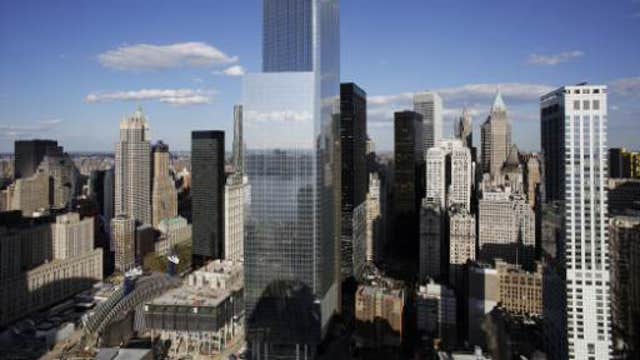In 4 World Trade Center, Big Data Meets Elevators
Thirteen years after the worst terrorist attack on American soil, the World Trade Center site is well on its way to taking on a new life of its own. With the 9-11 Memorial and Museum open to the public, and One World Trade Center construction mostly completed, there’s new energy and a feeling of re-birth in lower Manhattan.
Builders at the iconic site have capitalized on this fresh start by installing state-of-the-art green technology and safety measures that will certainly save energy and possibly some lives.
While most of the attention on the site has focused on political issues and what the construction and re-building symbolizes, there’s been a big push behind the scenes to put the final touches on what is the first building at the World Trade Center complex to officially open.
Four World Trade Center is a 971-foot tall tower offering 2.3 million square feet of office space, while also featuring shops, restaurants, and access to New York City’s subway system at its base. The building, which opened officially in November 2013 is now 60% leased, and building managers say they hope to see companies move in within the next year or two.
In addition to its first-opened status and panoramic views looking north into New York City and south toward the Statue of Liberty, the building also boasts a number of environmental features. Dara McQuillan, chief marketing and communications officer at Silverstein Properties, said the goal was to build one of the greenest office buildings in New York. To do that, the company looked to the core of the building – a feature to which not many give more than a passing glance – to transform the way employees move from floor to floor.
“We partnered with Schindler (Elevator) to design an elevator system that was fast and energy efficient,” McQuillan said. “The elevators are fast, they’re quiet, they get you up and down in no time at all, and they save a huge amount of energy and electricity.”
There are a number of factors that go into making the elevators environmentally friendly including high-efficiency AC motors, power factor drives that return power back to the building, and port technology that that optimizes traffic flow. Jerry Piserchia, Shindler’s senior project manager, said to think of it like airplane travel versus bus transportation.
“(As) opposed to a conventional system which is kind of like a local bus where you just get on the first elevator traveling in that direction and making stops, this system is more like an airplane: I wouldn’t go to the airport and expect to get on a plane that’s heading west and making several stops.”
These elevators group people with the same or similar destinations. Because of that, the building saves 20% on power usage from the elevator system, which also contributes to the other “green” aspects of the building like 30% less water usage thanks to collected rainfall. Meanwhile, 80% of the building’s steel comes from recycled sources, and 100% of the energy used is from renewable sources.
The designers of 4 WTC admit they’re not the first to establish a green office building. But when coupled with the functionality, the elevators offer a whole new user experience.
The Schindler elevators “talk” to the turnstiles where employees enter. Once an ID is swiped, the elevator is called for the floor that user typically visits first on a given day (that’s a programmable feature). It’s then timed to open as the user approaches the elevator, and then takes the user to the desired floor.
But the developers go even one step further.
The system’s algorithm will learn if, say, a tenant typically visits two or three floors in succession at a certain point of the day and automatically route them that way with the swipe of an ID card.
“I could program that every time I leave my floor, I go to the 52nd floor, that’s the cafeteria. I can present my badge and the elevator will automatically take me to the 52nd. From there, I want to go to the gym, it’ll automatically do that as well,” Piserchia said.
On Hallowed Ground, Safety a Top Priority
Given 4 WTC and other new buildings in the complex are constructed feet from the site of one of the worst tragedies in American history, safety is a paramount concern.
With that in mind, Schindler programmed special features into its entry systems and elevators – some of which they can disclose, others that remain safeguarded.
Each employee’s ID badge communicates with the building’s 37 elevators and lets the building’s systems know who is in the building and what floors or areas those people are accessing at any time.
“If desired by the tenant, we can feed that information back to them so they can track who is on what floor,” Piserchia said. “So they issue the credentials for who can get in the building, we take care of tracking where they are throughout.”
The elevators also provide protection against commonly transmitted illnesses as well, a different, but equally important safety measure. With its third-generation destination-dispatch system (which allows users to swipe their IDs and seamlessly make it to their desired floor) a number of touchless features are available to users
“A lot of these features have been built in for a number of different reasons including security, preferences, and even in some cases like when SARS was going around Asia and people didn’t want to be touching elevator call buttons,” Piserchia said, referring to the outbreak of Severe Acute Respiratory Syndrome.
What's more, a sticker can be affixed to a key FOB, watch, or the like so users don’t have to keep the card in their pockets. Instead, they can take out whatever the sticker is applied to, swipe it at a port on the wall, and their elevator request will go through as normal.
